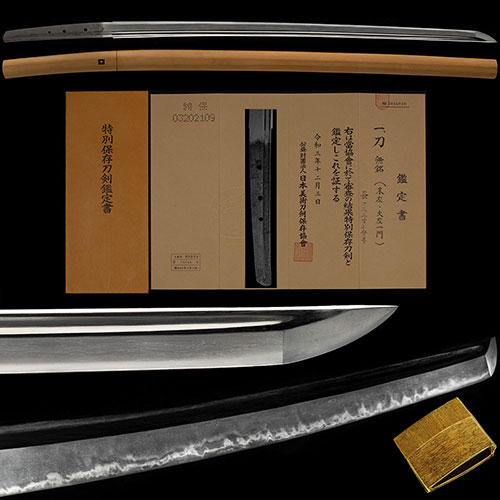
末左 刀 Suesa Katana
No.264104末左 大左一門 南北朝時代 映り立ち金筋沸筋頻りに掛り匂口明るく冴える名品 二尺三寸四分Suesa Ohsa Ichimon Nanbokucho period, Utsuritachi Kinsuji and Niesuji shikirini-kakari, Nioikuchi is bright and clear a masterpiece 70.8cm
ご成約Sold
- 極めKiwame
- 末左Suesa
- 登録証Registration
- 大阪府 Osaka 昭和49年11月19日 11/19/49(Showa)
- 時代Period
- 南北朝時代Nanbokucho era
- 法量Size
-
刃長 70.8cm (二尺三寸四分) 反り 0.5cm
元幅 3.0cm 先幅 2.0cm 元重 0.68cm 鎬厚 0.71cm 先重 0.48cm 鋒長 4.1cm 茎長 20.4cm 重量 731gHachou 70.8cm (二尺三寸四分) Sori 0.5cm
Moto-Haba 3.0cm Saki-Haba 2.0cm Moto-Kasane 0.68cm Shinogi-Thikess 0.71cm Saki-Kasane 0.48cm Kissaki-Chou 4.1cm Nakago-Chou 20.4cm Weight 731g - 国Country
- 筑前Chikuzen
- 姿Shape
- 鎬造、庵棟、身幅広く、反りやや浅く、腰反りつき、中鋒やや延びる。Shinogidukuri, Iorimune, Wide Mihaba, Slightly Shallow Sori, Koshizori-tsuki, Chu-Kissaki slightly extended.
- 鍛Kitae
- 板目肌に、流れ肌交じり、地沸厚くつき、地景よく入り、映り立つ。Itamehada, Mixed Nagarehada, Jinie entered thick, Chikei entered well, Utsuritatsu.
- 刃文Hamon
- のたれて、互の目に、小互の目・丁子刃など交じり、湯走り・飛び焼き・二十刃掛かり、足よく入り、沸深くよくつき、金筋・沸筋・砂流し頻りにかかり、匂深く、匂口明るく冴える。Notare, gunome, Smalll-Gunome, Mixed Choujiba, Yubashiri, Tobiyaki, Nijuba-kakari, Ashi entered well, Nie entered deeply, Kinsuji and Niesuji, Sunagashi-shikirinikakari, Deep Nioi, Nioikuchi is bright and clear.
- 帽子Boushi
- 金筋掛り、乱れ込んで先掃きかけて尖りごころに返る。Kinsuji-kakari, Midarekonde-sakihakikakete-togarigokoroni-kaeru
- 茎Nakago
- 表裏に棒樋を掻き通す。Squeeze Bohi inside and out
- ハバキHabaki
- 金着二重。Double gold
- 説明Drscription
- 筑前国左文字は、大左と通称され、実阿の子と伝え、銘文の左は、左衛門三郎の略という。相州正宗十哲の一人に数えられ、それまでの古典的な九州物の作域から大いに脱皮し、地刃共に明るく冴え、地景や金筋の目立つ新作風を確立した。左一門は、南北朝期に大いに栄えたが、大左の子と伝える貞吉・安吉を始め弘行・国弘などがいて、これら左一門を末左と呼称する。この刀は、身幅広く、やや反り浅く、腰反り付き、鋒延びごころの南北朝の姿で、板目肌に、流れ肌交じり、地沸が厚くつき、地景がよく入り、肌だちごころに、やや黒みを帯びた映り立つ地鉄に、互の目・丁子刃などが交じり、足よく入り、沸深くつき、金筋・沸筋・砂流し頻りに掛るなど働き豊かで、匂口明るく冴える名品である。Chikuzennokuni Samonji is commonly known as Ohsa and is said to be a child of Jitsua, and the inscription Sa is an abbreviation for Saemon saburou. He was one of Sousyu Masamunejittetsu, and he was a big break from the classic Kyusyu production area, and he was bright and clear with Jiba, establishing a prominent new style of Chikei and Kinsuji. The only existing Tachi in existence is the national treasure "Kousestsu Samonji", but there are relatively many examples of Tantou. The Sa family prospered greatly during the Nanbokuchou period, but there are Sadayoshi, Yasuyoshi, Hiroyuki, Kunihiro, etc. who are said to be children of Ohsa, and these Sa families are called Suesa.
This sword has Wide Mihaba, Slightly shallow Sori, Koshizori-tsuki, Kissaki-nobigokoro Nanbokucho-style, Itamehada, Mixed Nagarehada, Jinie entered thick, Chikei entered well, Hadadachi-gokoro, Utsuritatsu Jigane with a slight blackness. Gunome and Mixed Choujiba, Ashi entered well, Deep Nie-tsuki, Kinsuji, Niesuji and Sunagashi-shikirini-kakaru, It is a masterpiece that works well and Nioikuchi is bright and clear.


